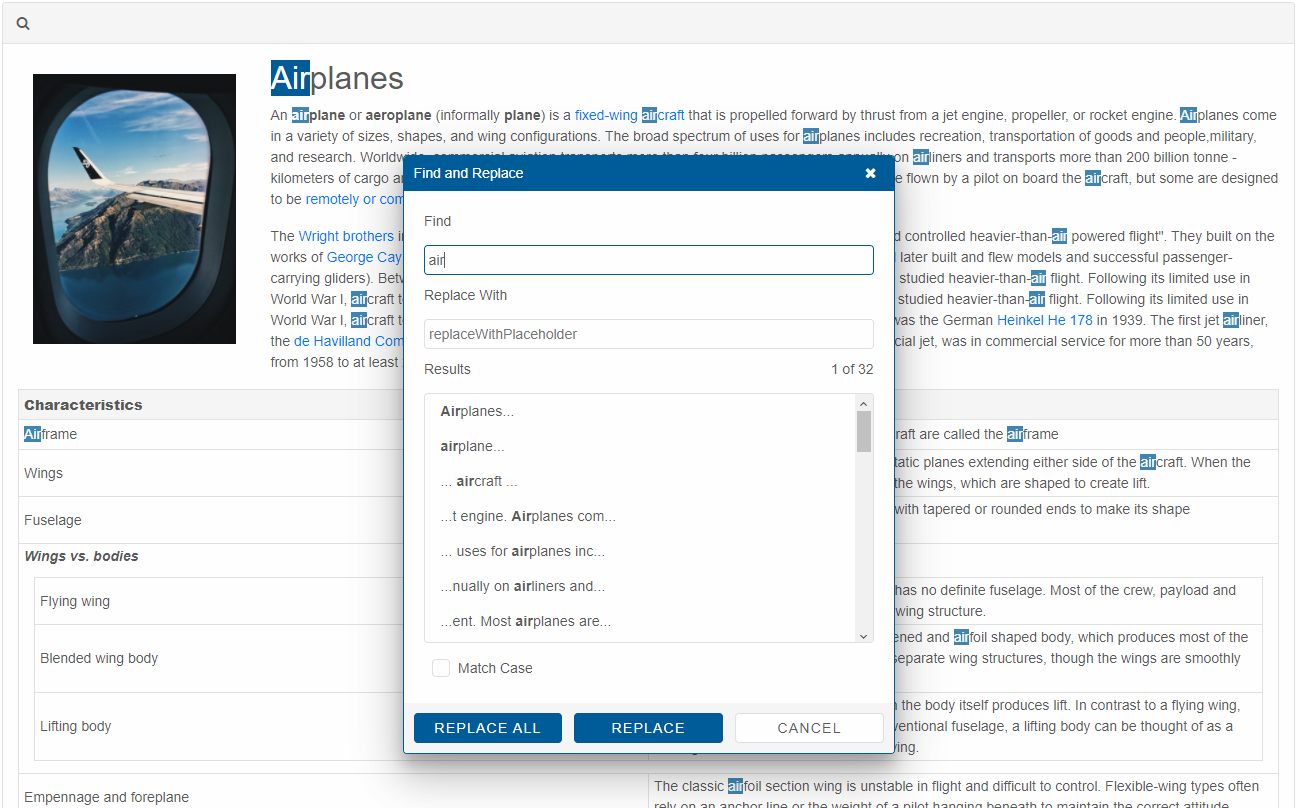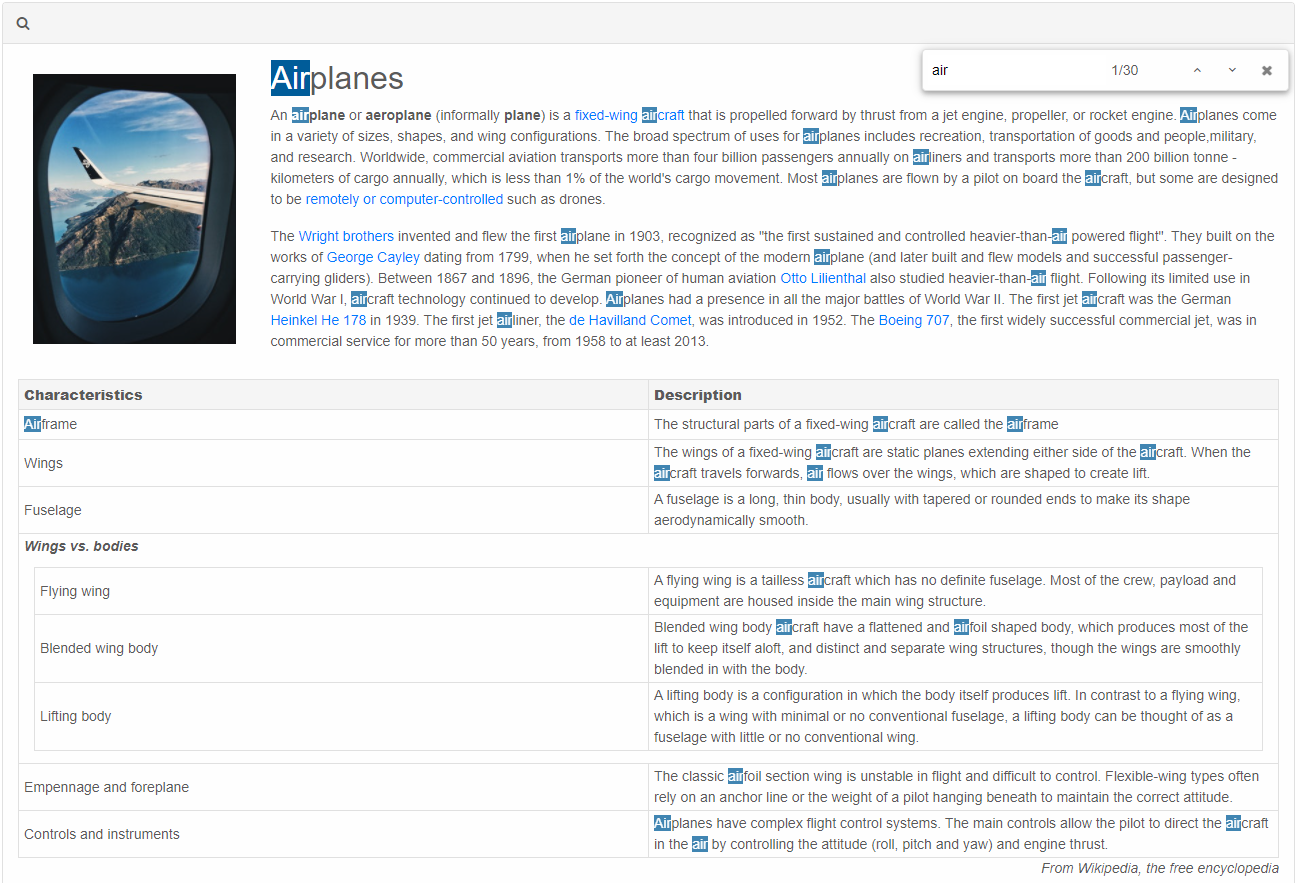Editor Find and Replace
Setup The Blazor Application
Follow the Getting Started guide to set up your Blazor Application with Smart UI.
Setup the Blazor Smart.Editor
Follow the Get Started with Smart.Editor guide to set up the component.
Find and Replace
Smart.Editor toolbar has many actions that can modify the content. Some of the them are more complex and offer greater capabilities.
Such is the Find and Replace feature.
The Find and Replace toolbar actions triggers a dialog window that allows to search for a specific text inside Editor's content. The matches found are displayed inside a list box and can be replaced by another string also defined by the user in a separate text box.
The text matches are highlighted inside the Editor and the user can navigate between the matches via the dialog window.
By default the matching criteria is case insensitive. However there's an additional option to match the case of the search string.
The Find and Replace feature is available only when the EditMode is set to "HTML" (default).
Example
Here is an example of how you can use the Smart.Editor's Find and Replace:
<Editor ToolbarItems="toolbarItems" ContextMenu="EditorContextMenu.Browser">
<div class="airplanes">
<img src="./images/travel/15.jpg" alignment="left" height="300" />
<h2>Airplanes</h2>
<p>
An <b>airplane</b> or <b>aeroplane</b> (informally <b>plane</b>) is a <a href="https://en.wikipedia.org/wiki/Fixed-wing_aircraft" title="Fixed-wing aircraft">
fixed-wing
aircraft
</a>
that is propelled forward by thrust
from a jet engine, propeller, or rocket engine. Airplanes come in a variety of sizes,
shapes, and wing configurations. The broad spectrum of uses for airplanes includes recreation,
transportation of goods and people,military, and
research.
Worldwide, commercial aviation transports more than four billion passengers annually on airliners and
transports more
than 200
billion tonne - kilometers of cargo annually, which is
less than 1% of the world's cargo movement. Most airplanes are flown by a
pilot on board
the aircraft, but some are designed to be <a href="https://en.wikipedia.org/wiki/Unmanned_aerial_vehicle"
title="Unmanned aerial vehicle">remotely or computer-controlled</a> such as drones.
</p>
<p>
The <a href="https://en.wikipedia.org/wiki/Wright_brothers" title="Wright brothers">Wright brothers</a>
invented
and flew the first airplane in 1903, recognized as "the first sustained and controlled
heavier-than-air powered flight". They built on the works of <a href="https://en.wikipedia.org/wiki/George_Cayley" title="George Cayley">George Cayleylt;/a> dating
from 1799,
when he set forth the concept of the modern airplane (and later built and flew models
and successful passenger-carrying gliders). Between 1867 and 1896,
the German pioneer of human aviation <a href="https://en.wikipedia.org/wiki/Otto_Lilienthal"
title="Otto Lilienthal">Otto Lilienthal</a> also studied heavier-than-air flight.
Following its limited use in World War I, aircraft technology continued to
develop. Airplanes had a presence in all the major battles of World War II. The first
jet aircraft was the
German <a href="https://en.wikipedia.org/wiki/Heinkel_He_178" title="Heinkel He 178">Heinkel He 178</a>
in 1939. The
first jet airliner, the <a href="https://en.wikipedia.org/wiki/De_Havilland_Comet"
title="De Havilland Comet">
de Havilland
Comet
</a>,
was introduced in 1952. The <a href="https://en.wikipedia.org/wiki/Boeing_707" title="Boeing 707">
Boeing
707
</a>, the first widely successful commercial jet, was in commercial service for
more than 50 years, from 1958 to at least 2013.
</p>
<table>
<thead>
<tr>
<th> <b>Characteristics</b> </th>
<th> <b>Description</b> </th>
</tr>
</thead>
<tbody>
<tr>
<td> Airframe </td>
<td> The structural parts of a fixed-wing aircraft are called the airframe </td>
</tr>
<tr>
<td> Wings </td>
<td>
The wings of a fixed-wing aircraft are static planes extending either side of the aircraft.
When the aircraft travels forwards, air flows over the wings, which are shaped to create
lift.
</td>
</tr>
<tr>
<td> Fuselage </td>
<td>
A fuselage is a long, thin body, usually with tapered or rounded ends to make its shape
aerodynamically smooth.
</td>
</tr>
<tr>
<td colspan="2">
<b><i>Wings vs. bodies</i></b>
<div class="table-wrapper">
<table>
<tbody>
<tr>
<td>Flying wing</td>
<td>
A flying wing is a tailless aircraft which has no definite fuselage.
Most of
the crew, payload and equipment are housed inside the main wing
structure.
</td>
</tr>
<tr>
<td>Blended wing body</td>
<td>
Blended wing body aircraft have a flattened and airfoil shaped body,
which
produces most of the lift to keep itself aloft, and distinct and
separate
wing structures, though the wings are smoothly blended in with the body.
</td>
</tr>
<tr>
<td>Lifting body</td>
<td>
A lifting body is a configuration in which the body itself produces
lift. In
contrast to a flying wing, which is a wing with minimal or no
conventional
fuselage, a lifting body can be thought of as a fuselage with little or
no
conventional wing.
</td>
</tr>
</tbody>
</table>
</div>
</td>
</tr>
<tr>
<td>Empennage and foreplane</td>
<td>
The classic airfoil section wing is unstable in flight and difficult to control.
Flexible-wing types often rely on an anchor line or the weight of a pilot hanging beneath to
maintain the correct attitude.
</td>
</tr>
<tr>
<td>Controls and instruments</td>
<td>
Airplanes have complex flight control systems. The main controls allow the pilot to direct
the aircraft in the air by controlling the attitude (roll, pitch and yaw) and engine thrust.
</td>
</tr>
</tbody>
</table>
<p style="text-align: right;"><i>From Wikipedia, the free encyclopedia</i></p>
</div>
</Editor>
@code
{
List<IEditorToolbarItem> toolbarItems = new List<IEditorToolbarItem>()
{
new EditorToolbarItem() { Name = "findAndReplace" }
};
}
Result:
Search Bar
An additional Search bar is also available for users who want to quickly find the desired text inside the Editor's content section.
The search bar is enabled by default and can be triggered via a keyboard combination: Control + F only when the Editor's content section is focused.
The Search bar feature is only avaialble for EditMode HTML.
The Search bar is case insensitive and can be disabled via the DisableSearchBar property.

The FindAndReplaceTimeout property determines the timeout before the search criteria is applied and the results are displayed.
The property is used for both find and replace and search bar features.